The tagline for ManSpace Magazine is ‘Inside the World’s Best Garages, Sheds and Mancaves’, so we couldn’t do much better than to take you into Australia’s biggest shed.
Spanning the length of more than five Olympic swimming pools, the Murtoa Stick Shed is a construction that needs to be experienced in person to fully appreciate.
And thankfully, after almost 20 years in isolation and more than $1.5 million in restoration work, that is about to become a whole lot easier.
The Murtoa Stick Shed was constructed in 1941 as a solution to grain storage during the World War II
wheat glut, when exports were restricted. While New South Wales had constructed some large concrete silos for bulk storage, Victoria had been slow to adopt a similar principle with only a few small silos around the Wimmera. Throw in the fact that traditional storage methods (hessian bags and cornsacks) became scarce and war time was restricting exports, Victoria needed somewhere to store excess harvest yields. Given the proximity to crops and an existing railway, the town of Murtoa (a little over 300km north-west of Melbourne) was chosen as the site for a bulk storage solution.
Constructed from 560 unmilled poles or ‘sticks’ (spanning 56 rows of 10), The Shed runs an incredible 270m in length, 60m in width and roughly 19m high along the ridge. Not surprisingly, it was soon dubbed the ‘Stick Shed’.
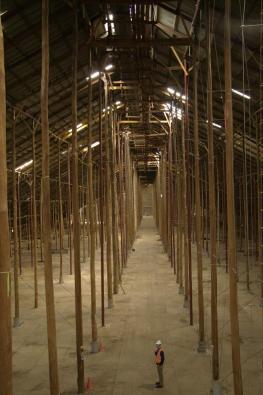
Even more amazing was that the work commenced on 25 September 1941 and the store was ready to receive wheat in January 1942 – I’m not sure even McDonald’s could put up something that quick…
The Shed itself is a fairly simple construction, but the entire solution was a massive leap forward in handling harvested crops. Grain was lifted by elevators in the working house to a conveyor belt which ran the full length of the building, just under the apex of the roof. Wheat could be dropped to the floor from the conveyor belt at any point along the line. To the average farmer in 1942, working with elevators, conveyor belts, trucks and railways was very modern indeed.
The Murtoa Stick Shed was the first of its kind built, with similar storage solutions constructed around Victoria and New South Wales over the coming decade. Murtoa even had a second shed constructed (a larger one, if you can believe it) barely two years later. This original shed, however, is the last one remaining in the country.
While an enormous timber-framed shed complete with a concrete floor may seem a little primitive for grain storage by today’s standards, the Stick Shed remained in operation until 1989 when the Grain Elevator’s Board (GEB) argued that it was no longer economic.
What followed was a period of limbo for both The Shed and the town of Murtoa. Over time, questions were raised about the validity of keeping such a structure as it sat there slowly deteriorating.
At this time, Leigh Hammerton moved from the dairy farming district of Colac to the crop farming district of Murtoa – a form of ‘farming-change’ (as opposed to a sea-change). He was immediately struck by the Stick Shed and has since become something of a local voice (and humble authority) for it – publically defending its validity and potential, even in its darkest hours.
“I moved to Murtoa in 1990 and one of the first things you notice in the town is the Stick Shed,” says Leigh. “But, let’s be honest, how could you miss it?
“The first time I was able to go in, it completely floored me. I understand how it looks from the outside but once you get inside, it’s incredible. The sheer size of it is hard to comprehend until you are standing within its walls.
“That period was the last time it was in operation – the 1989/1990 wheat season – so when I got in there it had just been cleaned out and was spotless.”
Upon its closure, however, The Shed sat idle – no one was quite sure what to do with it. A defining moment came in 1992 when the GEB put in a submission to have The Shed removed so the land could be used for other purposes. A group of Murtoa locals went to Melbourne and faced VCAT (Victorian Civil and Administrative Tribunal), managing to get The Shed placed on the Heritage Victoria Register to prevent demolition.
“It was at that time that I became more involved locally,” explains Leigh. “Heritage Victoria came up here to understand more about it, and I helped show them around and explain what I knew about it.”
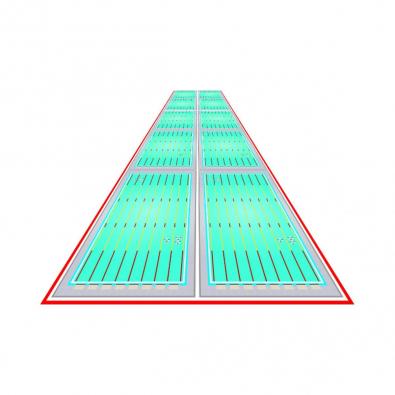
With The Shed no longer in operation and no repairs undertaken, the structure began to deteriorate rapidly.
“The first real issue came when some of the sheeting came loose from the roof,” explains Leigh. “It was during harvest season, and with The Shed surrounded by wheat fields it was incredibly dangerous to have these sheets of corrugated iron flying around the place.”
The whole building was then covered in Emu Mesh (a strong wiring mesh) to hold everything together – a modification that is still around much of the structure now.
Although it bought a bit of time, it was never going to be a long-term solution, and over the next 15 years or so, there was a simmering difference of opinion throughout the town. While some thought of The Shed as a unique historical structure with potential for the town, others simply saw it as a large mess of deteriorating timber and metal, using up valuable space and posing a risk to the safety of others nearby.
Although Leigh readily acknowledges that it was the Heritage Council of Victoria who funded and undertook the restoration work, he maintained his positive belief in The Shed and spoke out in favour of it – unofficially becoming its spokesperson.
A further complication occurred when the GEB was privatised in the mid-1990s and became Vic Grain. This new privately-owned company bought the entire infrastructure around the Murtoa site, but didn’t want the storage facility. As a result, The Shed remained government-owned, but all of the surrounding land was now in private ownership – meaning, you couldn’t even get access to it without permission. The Stick Shed was now effectively a diminishing structure on a paddock island that few people had access to.
Throughout this time the Heritage Council of Victoria was looking for a solution to restore The Shed with on-going viability behind it. But trying to find someone who would take on a building that required over a million dollars worth of repairs was always going to be difficult.
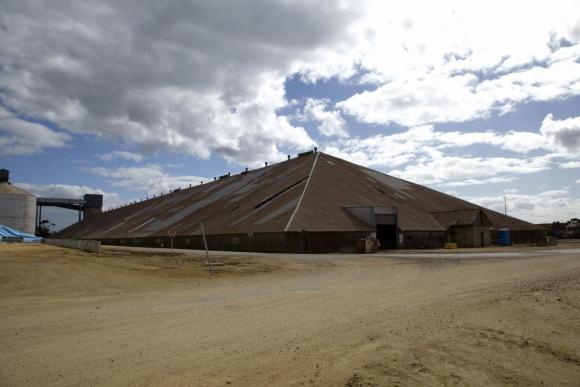
Martin Zweep is a conservation officer with Heritage Victoria and has been managing the restoration of the Murtoa Stick Shed for the Heritage Council. He says that the most important moment came when they were able to secure finances to undertake the restoration themselves with the view that they could find a suitable use for it after the works were completed.
“A few years ago the Heritage Council of Victoria recognised that it was one of the most unique buildings in the state, despite its rather rudimentary nature, and therefore it should be conserved,” explains Martin.
“So we set about obtaining the funds to undertake the restoration. We signed a contractor, Greg Owen of Period Building Conservation, to the job in late 2008 and early in the following year he went through the entire site to survey its condition so we knew the best way to approach the job.”
Even with an official plan formulated, the contractor only managed to get 10 days of work under his belt, when WorkSafe Victoria came in and shut the site down for safety reasons. What followed was another 10 months of negotiations to convince WorkSafe that the building was not unsafe, and that the work being undertaken was to repair the damaged areas.
In September 2010 the works commenced in earnest and it is just coming to completion now. The contractors started at the eastern end (as it was considered the most damaged) and literally worked their way along the length of the construction.
“The repairs were not actually all that complicated; it was purely the sheer enormity of it,” says Martin.
“A major reason why the building has stood up so well is because of its simplicity in construction. It’s actually a very clever construction in that it is essentially held together with strapping, but it’s a testament that it should be holding up so well after 70 years.
“Greg Owen went through the shed and tested every pole individually to gauge its strength. Amazingly, the great majority were in very good condition; however there was one issue from the original construction – the poles had been dug directly into the ground. There’s quite a high water table there, so the base of the poles became wet over time and that was the perfect invitation for termites.
“In the past, one repair technique had been to cut the base of the pole and form a concrete block underneath it for stability – so we essentially formalised that method and went through the entire structure providing each pole with a concrete footing.”
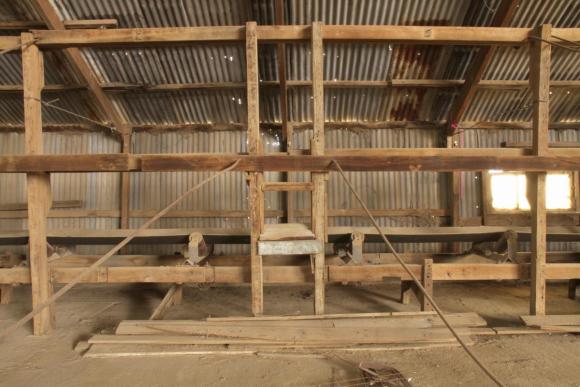
In an interesting note, there was less termite damage, but greater roof damage, at the west end of the building. The answer lies in the way in which it was used in operation.
“The Shed was filled from the west to the east but emptied from the east to the west – meaning there was always more grain on the west side,” explains Martin.
“The engineers believe that the extra grain in that side helped give it stability, plus the extra heat generated by that grain made it hard for termites to live. Conversely, the extra wheat on the west side meant that more dust got into the roof which, combined with condensation, created the perfect conditions to rust out the corrugated iron.”
Although the restoration is not officially complete, The Shed has been deemed safe for the public – however the limited access has restricted many opportunities so far.
There have been two open days, both of which attracted large numbers of people. Understandably, the first was predominantly made up of locals, many of whom had never been inside.
“I think that was a really important day for The Shed,” says Leigh. “You need to remember that there has been essentially no access to it for over 20 years, so a whole generation of people who live in the area have driven past it but never been able to see inside. For them, it was this mass of rusted metal in the distance that looked like it could fall over at any time.
“But that moment when they could get inside and see the rows of poles and sheer vastness of the structure – all of them stopped, took a breath and understood what we had been fighting for.”
Now that the restoration is almost complete, the challenge becomes establishing the best way to utilise The Shed so that it can become self-sufficient and give something back to the town.
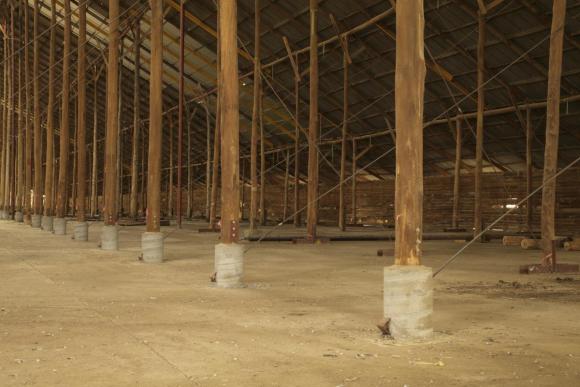
“For me, the beauty of it is when you stand in the middle of it and feel its vast emptiness – so no matter what is settled on, I do hope that it doesn’t end up being filled with bits and pieces and lose its uniqueness.
“Ultimately, I hope it can get to a point where it is able to be handed over to a local committee – with the support and input of Heritage Victoria obviously – so that it can be managed by those who live with it. It’s a local landmark, built by locals and still very much part of this town’s make-up – so I would love to see local input and control to some level.”
Martin is also keen to see some local management of The Shed, saying he sees potential to utilise its space across a wide range of activities – thereby driving new people to the town for different reasons.
“When you stand in there with that amazing cathedral-style ceiling and see the rows of sticks, you can’t help but feel humbled by the size. I personally could see travelling exhibitions, car club events, art galleries, markets, concerts and so many other options using it on a rotating or casual basis – it would only add to an event to be in such a setting.”
Whatever the final use may be, it is a wonderful result that such a unique structure – and one that reflects so much of our local history – has been retained for future generations to enjoy. And once the access dilemma has been sorted I’m sure the opportunities for a visit will be flowing.
When you do get there however, it is worth keeping one thing in mind. As you stand there and try to take in the sheer vastness of it all, remember that the design makes for perfect acoustics across all 270m in length – so be mindful that there’s no ‘private conversations’ with the person beside you…





